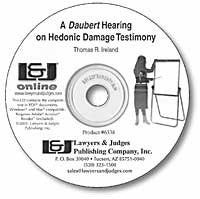
Practice of Forensic Human Factors/Ergonomics and Related Safety Professions
- Author: Melvin H. Rudov & H. Harvey Cohen
-
ISBN-10: 1-933264-09-8
- ISBN-13: 978-1-933264-09-7
- Copyright Date Ed: July 8, 2005
- Pages: 275
- Binding Information: Casebound
- Size: 8.5 ✕ 11 Inches (US)
As a human factors/ergonomics specialist you will find this text to be a great help in handling forensic consulting projects. As an attorney and other legal professional you will find it of value when determining if a human factors/ergonomics expert is needed, what the expert does, how to help prepare the expert for testimony and more.
It is also valuable to you as a professional in a related area who would like to have an understanding of this field, as well as forensic practice in general. This book teaches you about the four main liability areas: premises liability, product liability, transportation liability, and recreational liability, and the issues and unique aspects of each. It also covers aspects of work practice such as interviews, reports, gathering evidence, site visits, statements, depositions, trial testimony, and more.
Both plaintiff and defense case examples are used extensively throughout the book to give you a thorough understanding of the process involved. Appendices give you examples of reports, depositions, fee agreements and more.
This book is also available as an eBook. Click here to purchase and download:
Table of Contents:
Section One: The Legal Basis Of Forensic Practice
Chapter 1: Introduction
1.1 Introduction
1.2 The Nature of a Forensic Practice
Chapter 2: Structure of the American Court and Legal Systems
2.1 The Structure of the Court System
2.2 The Nature of the Legal Matters in Forensic Practice
A. Intentional Torts
B. Negligent Torts
C. Strict Liability
D. Civil Assault
E. Civil Battery
2.3 Variants Of Tort Law
Chapter 3: The Rule of Law and the Law of Rules
3.1 The Rules of Civil Procedure
A. Pleadings
B. Discovery
1. Depositions
2. Interrogatories
3. Requests to Produce
4. Request to Inspect Evidence
5. Requests for Admissions
6. Compelling a Medical Examination
C. Trial Procedure
3.2 The Rules of Evidence
Chapter 4: Forensic Work Products
4.1 The Intake Interview
4.2 Opinion Conference
4.3 Site Visits
4.4 Pre-trial Statements
4.5 Forensic Reports
4.6 Affidavits (Declarations)
4.7 Testimony Section Two: Technical Content Areas
Chapter 5: Premises Liability
5.1 Legal Underpinnings
5.2 Premises Liability Accident Types
A. Slips, Trips, Stubs, Missteps and Falls
1. Slip Cases
5.3 Other Premises Injuries
Chapter 6: Product Liability
6.1 Legal Underpinnings
6.2 Specific Issues
A. General Approach
B. Misuse
C. Populations
D. Industrial and Commercial Products
E. Economic Feasibility
F. Warning Issues
G. Design
H. Alcohol and Other Forms of Temporary Debilitation
I. Learned Intermediaries
6.3 Some General Considerations in Accepting Cases
Chapter 7: Transportation Liability
7.1 On-Road Vehicular Accidents
A. Road Factors
B. Signage Factors
C. Vehicular Factors
D. Human Factors
7.2 Off-Road Vehicular Accidents
7.3 Railroad Accidents
A. Visibility
B. Sounds
C. Earth Vibrations and Directionality
D. Panic
E. Signage
7.4 Airplane Accidents
7.5 Watercraft Accidents
Chapter 8: Recreational Liability
8.1 Playgrounds
8.2 Playing Fields
8.3 Amusement Parks
8.4 Swimming Pools
Chapter 9: An Ergonomics Safety Design Success Story
9.1 Case Study Facts
9.2 Prevalence of Trunk Entrapment
9.3 Development of an Ergonomically-Designed Trunk Release Handle
9.4 Test and Evaluation
9.5 Ergonomically-Designed Trunk Release Handle
9.6 Disposition of the Case
Appendix A: Example of an Expert Affidavit/Declaration
Appendix B: Excerpts from an Expert Deposition
Appendix C: Example of an Expert Report
Appendix D: Example of a Retention Fee Agreement
Appendix E: Human Factors and Ergonomics Society and Forensic Professional Group White Paper
References
Bibliography
Sources of Human Factors/Ergonomics Experts




